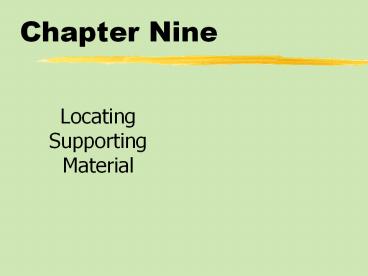Chapter Nine - PowerPoint PPT Presentation
1 / 20
Title:
Chapter Nine
Description:
Title: Chapter Seven Author: PSE&G Last modified by: Coleen O'Hanley Created Date: 11/14/1998 1:50:04 PM Document presentation format: On-screen Show – PowerPoint PPT presentation
Number of Views:155
Avg rating:3.0/5.0
Title: Chapter Nine
1
Chapter Nine
Locating Supporting Material
2
Chapter Nine
- Table of Contents
- Primary Resources Interviews and Statistics
- Secondary Resources Print and Electronically
Stored Sources
3
Locating Supporting Material
- Primary research
- Original or firsthand research conducted by the
speaker. - Secondary research
- The vast body of information gathered by others.
4
Primary Resources Interviews and Surveys
- Supporting materials drawn from primary research
can include any source developed directly by the
participants involved. - In addition to interviews and surveys there are
- Oral or written histories
- Diaries
- Recordings of meetings
5
Primary Resources Interviews and Surveys
- Before You Begin Planning a Research Strategy
- Interviews
- Surveys
6
Primary Resources Interviews and SurveysBefore
You Begin Planning a Research Strategy
- Keep the reason for your search in mind.
- Review thesis statement.
7
Primary Resources Interviews and
SurveysInterviews
- The wording of a question is almost as important
as the information it seeks to uncover. - Avoid
- Vague questions which dont give the interviewee
enough to go on. - Leading questions which encourage, if not force,
a certain response. - Hostile questions which reinforce interviewers
agenda.
8
Primary Resources Interviews and
SurveysInterviews
- By taking notes, tape-recording, or video-taping,
you neednt reconstruct from memory what was
said. - Always get permission ahead of time.
- Allowing the interviewee to set the pace and
select the time and place is how you conduct the
interview professionally.
9
Primary Resources Interviews and SurveysSurveys
- Surveys are an effective source of support for
topics related to the attitudes, beliefs, and
values of people in your immediate environment.
10
Secondary Resources Print and Electronically
Stored Sources
- Database
- A searchable place or base where information is
stored, such as books or computers
11
Secondary Resources Print and Electronically
Stored Sources
- Resources to Facilitate Your Search
- Books
- Newspapers and Periodicals
- Government Publications
- Reference Works
- Critically Evaluating Secondary Sources
12
Secondary Resources Print and Electronically
Stored SourcesResources to Facilitate Your
Search
- If conducting your research in a library, seek
the assistance of reference librarians. - Card or online catalog
- Catalog of a librarys holdings
- Organized by author, title, subject
- Organized by Library of Congress call number or
Dewey decimal number
13
Secondary Resources Print and Electronically
Stored SourcesBooks
- A well-written book provides detail and
perspective and can serve as an excellent source
of supporting examples.
14
Secondary Resources Print and Electronically
Stored SourcesNewspapers and Periodicals
- Periodicals are regularly published magazines or
journals. - Most libraries have special computerized
databases that index past articles.
15
Secondary Resources Print and Electronically
Stored SourcesGovernment Publications
- The U.S. Government Printing Office (GPO) is
responsible for publishing and distributing all
information collected and produced by federal
agencies.
16
Secondary Resources Print and Electronically
Stored SourcesReference Works
- Encyclopedias summarize knowledge found in
original form elsewhere. - General encyclopedias attempt to cover all
important subject areas of knowledge. - Specialized encyclopedias delve deeply into one
subject area such as religion, art, sports, or
engineering. - Electronic encyclopedias cross-reference topics
via hyperlinks (highlighted words that link to
related topics).
17
Secondary Resources Print and Electronically
Stored SourcesReference Works
- Almanacs and fact books are geared towards facts
and statistics, and exist in both general and
specialized forms. - Biographical Resources provide information about
famous or noteworthy people. - Books of Quotations provide material for
introductions, conclusions, examples, narratives,
and testimony.
18
Secondary Resources Print and Electronically
Stored SourcesReference Works
- Poetry collections provide lines, or even entire
poems, for use by speakers in their
introductions, conclusions, and illustrations. - Atlases are collections of maps, text, and
accompanying charts and tables.
19
Secondary Resources Print and Electronically
Stored SourcesDocumenting Your Source Material
- Include
- Name of author or editor
- Title
- Volume or edition
- Name of publisher
- Place of publication, or Internet address
- Date and year of publication
- Page numbers
20
Secondary Resources Print and Electronically
Stored SourcesCritically Evaluating Secondary
Resources
- Consider the following when assessing the
validity of a source - What is the authors background and reputation?
- How credible is the publication?
- How reliable is the data?
- How recent is the reference?































